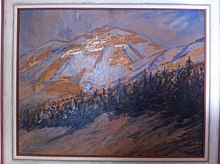Paul Gerhart Vowe
Paul Gerhart Vowe (born May 16, 1874 in Elberfeld (now part of Wuppertal ); † November 5, 1937 in Wehrau , Silesia ) was a German painter who spent most of his life in Berlin.
Career
Vowe studied since 1895 at the Berlin Academy of the Arts as a master student of Max Koner and Anton von Werner and later moved to the Munich Academy (as a master student of Carl von Marr ). He enjoyed social recognition as a portrait and landscape painter both during the imperial era and the Weimar Republic . During the First World War he served as a captain in the Vosges and Romania . After the war he was a freelance painter in Berlin . From around 1933 until his death in 1937 he lived in Klitschdorf , Bunzlau district , Silesia .
Creation and works
Paul Gerhart Vowe was a German painter from before and after the First World War, whose works are influenced by the styles of Realism and Impressionism . As a student of Anton von Werner , he initially had a large number of commissions for representative depictions of historical events, such as portraits of Emperors Wilhelm I and Wilhelm II in officers' mess or a monumental, 6 × 4 meter painting, which marked the opening of the Elberfeld town hall in Presence of Kaiser Wilhelm II represented. Later he was a portrait painter for a number of well-known personalities of the time. Before the First World War he portrayed the composer Richard Strauss as well as Prince Bernhard von Bülow and the Grand Duke Friedrich II of Baden . At the time of the Weimar Republic he made z. B. a portrait of the conductor Wilhelm Furtwängler (ill.). In contrast to the mostly realistic forms of portraits that follow the academic style, his landscape and flower pictures, the nudes and the depiction of everyday scenes are more related to German impressionism and emphasize the influence of light, colors and inner experience. Vowe painted children again and again, so there are a large number of child portraits such as the boy with an apple or the bathers . The best known is the lithograph Ludwig van Beethoven at a young age, which is exhibited in the Beethoven House in Bonn. From his time as an officer in World War I, there are drawings with war scenes, but also portraits. In his landscape paintings, landscapes around Berlin , the North Sea coast and later also the Giant Mountains and Silesia are shown.
Awards
- Adolph Menzel Prize 1899/1900.
literature
- Friedrich Jansa: German visual artists in words and pictures , Verlag Friedrich Jansa, Leipzig, 1912.
- Willy Oskar Dressler: Dressler's art manual , published by Enst Wasmuth AG, Berlin, 2nd volume, 9th edition 1930 / II, 1930.
- Westermannsmonthshefte 76th vol. 134, 1923, p. 508 ff.
- Westermannsmonthshefte 70th vol. 140, 1926, pp. 19 ff / 30 ff.
- The Art School No. 4, Illustrated Monthly for Art and Art Care, 1921, p. 98 ff.
- The Art School No. 8, Illustrated Monthly for Art and Art Care 1925, p. 6 ff.
- Rundschau, Verlag Armeemarinehaus, Berlin, 3rd year, 1924, pp. 4–5.
Web links
- Ludwig van Beethoven at a young age , accessed on August 4, 2013
| personal data | |
|---|---|
| SURNAME | Vowe, Paul Gerhart |
| BRIEF DESCRIPTION | German painter |
| DATE OF BIRTH | May 16, 1874 |
| PLACE OF BIRTH | Elberfeld |
| DATE OF DEATH | November 5, 1937 |
| Place of death | Wehrau , Silesia |



